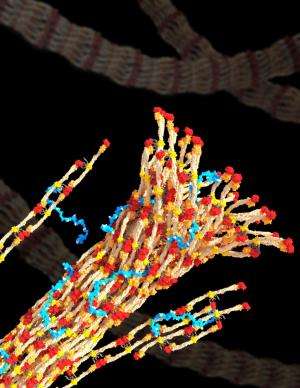March 6, 2015 report
Researchers develop polymer that helps wounds heal by strengthening clotting

(Medical Xpress)—A team of researchers at the University of Washington has announced the development of a polymer, than when injected into rats, helped slow bleeding by boosting clotting effectiveness. In their paper published in Science Translational Medicine, the team reports on the development of the polymer and the results they have seen in testing it on rats. Karim Brohi, with Queen Mary University in London, offers a Focus piece on the work, in the same journal issue.
Traumatic injuries sometimes cause more bleeding than the body is able to handle, causing the patient to die. But as Brohi explains, massive bleeding can present other problems to emergency workers as well—when a lot of blood is lost, the blood that remains has less ability to form strong clots, which means that even if bleeding can be stopped, the clots that form may not be strong enough to hold up to the increased pressure that occurs during a blood transfusion. In this new effort, the researchers report that their new polymer, called, PolySTAT helps with both problems.
The polymer, the team reports is the same one used to make contact lenses—engineered with a peptide that seeks out and binds to fibrin—a protein in the body that serves as straps to hold blood clots (which are made of platelets) in place. The polymer was designed to mimic an enzyme produced naturally in the body called Factor XIII—its purpose is to help glue fibrin strands to clots. The new polymer is injected into a blood vessel of an injured patient where it flows harmlessly until it comes across a blood clot being formed—then it binds to the clot, helping to make it stronger.
During testing, the researchers cut the femoral artery of 40 rats than injected half of them with PolySTAT. All of those treated lived, while half of those that were untreated died. Clots in the rats formed faster and were stronger than those that formed naturally.
The researchers believe their new polymer could someday soon make its way into emergency kits or operating rooms—they report that it is inexpensive to make and can be stored as a powder. And because it also makes clots stronger, it should help prevent new bleeding when patients are given transfusions.
More information: A synthetic fibrin cross-linking polymer for modulating clot properties and inducing hemostasis, Sci Transl Med 4 March 2015: Vol. 7, Issue 277, p. 277ra29 . DOI: 10.1126/scitranslmed.3010383
Abstract
Clotting factor replacement is the standard management of acute bleeding in congenital and acquired bleeding disorders. We present a synthetic approach to hemostasis using an engineered hemostatic polymer (PolySTAT) that circulates innocuously in the blood, identifies sites of vascular injury, and promotes clot formation to stop bleeding. PolySTAT induces hemostasis by cross-linking the fibrin matrix within clots, mimicking the function of the transglutaminase factor XIII. Furthermore, synthetic PolySTAT binds specifically to fibrin monomers and is uniformly integrated into fibrin fibers during fibrin polymerization, resulting in a fortified, hybrid polymer network with enhanced resistance to enzymatic degradation. In vivo hemostatic activity was confirmed in a rat model of trauma and fluid resuscitation in which intravenous administration of PolySTAT improved survival by reducing blood loss and resuscitation fluid requirements. PolySTAT-induced fibrin cross-linking is a novel approach to hemostasis using synthetic polymers for noninvasive modulation of clot architecture with potentially wide-ranging therapeutic applications.
© 2015 Medical Xpress


















